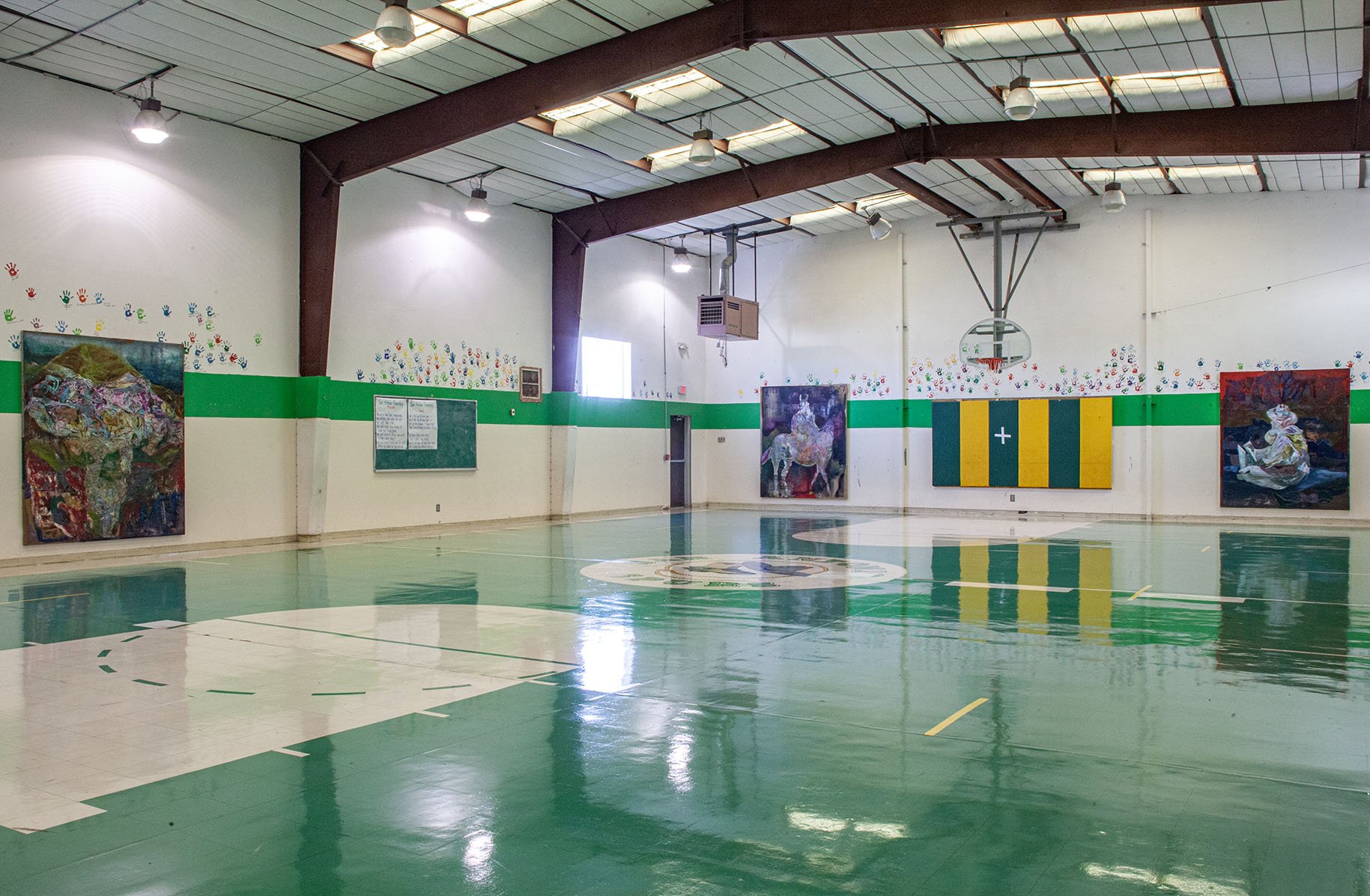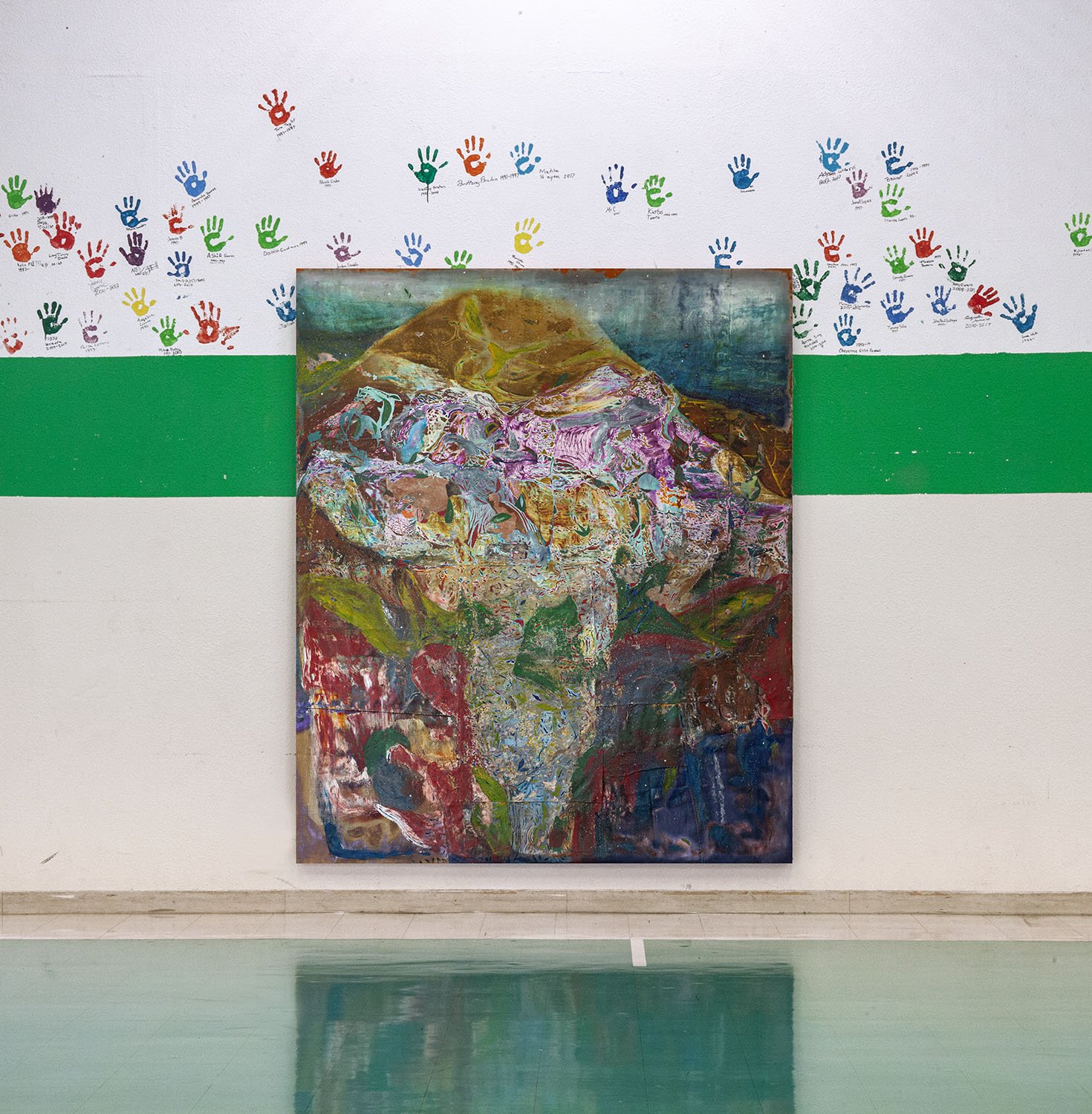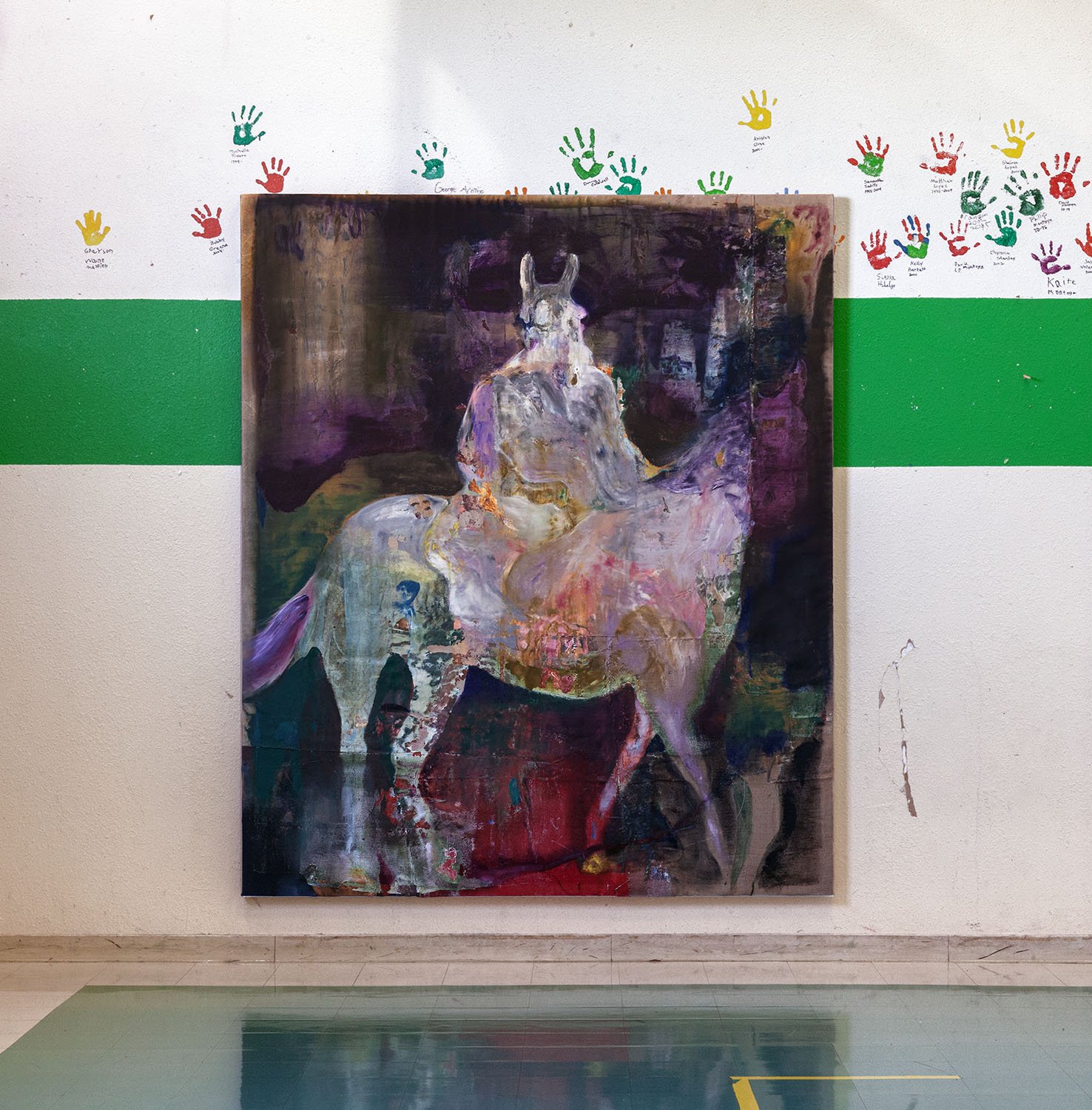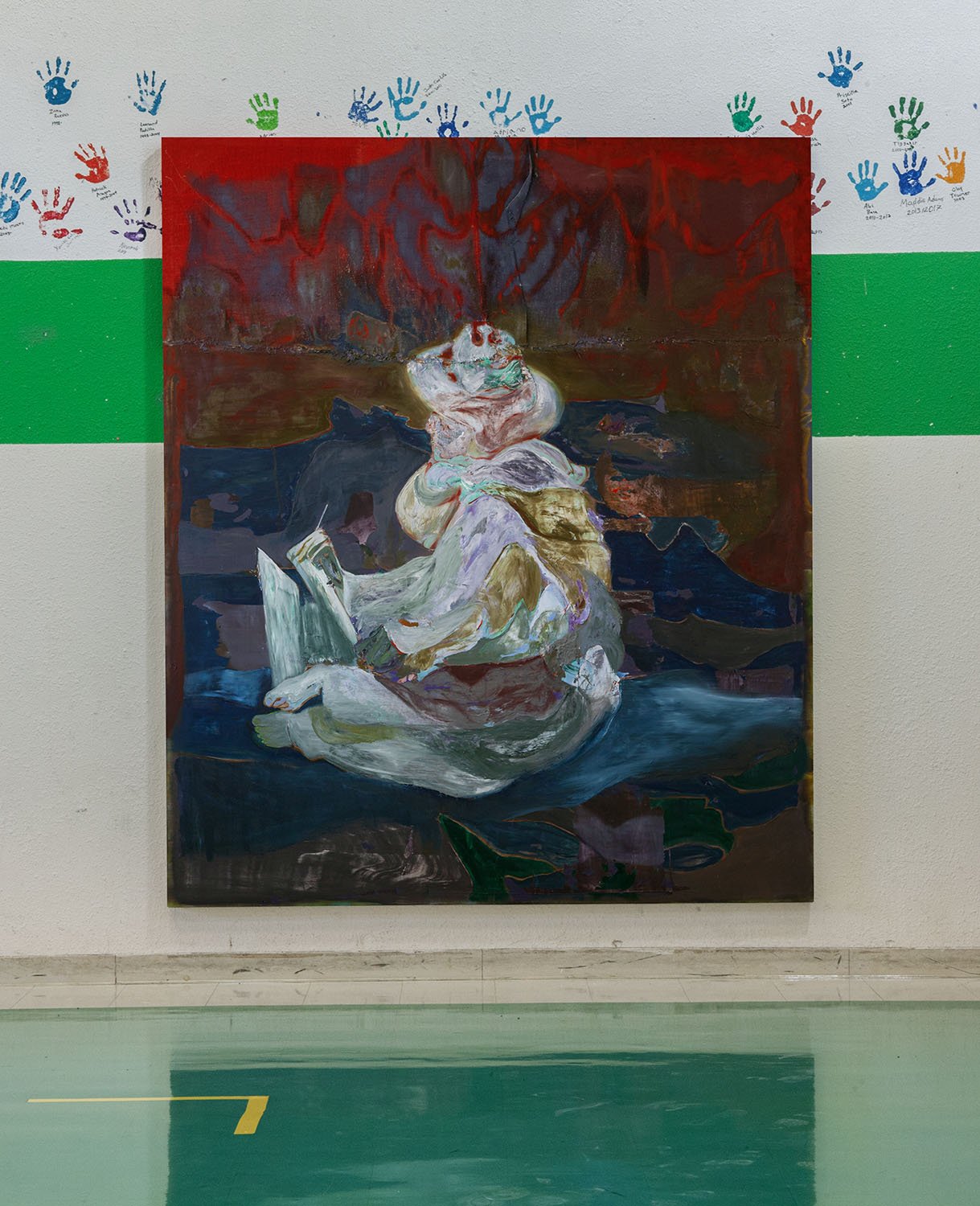Four Paintings
Nihil Installation in Abandon School in San Antonio New Mexico
“Sarah Was Ninety Years Old”
Sarah Was 90 Years Old, Installed in Abandon School in San Antonio New Mexico
I am still trying to make sense of these four paintings. They’re all 100 x 84 in. and they seem to hint toward a narrative I didn’t plan, which I’ll come back to. Each was made for the gymnasium at the abandoned San Antonio Elementary School, and were made at that size because 84 inches is the diagonal measurement of its largest door.
Of the four, “Sarah Was Ninety Years Old” is the most personal, I think, and the last completed. Its title is also the title of an Arvo Pärt composition. His phrase references Genesis. In it, Sarah, at ninety, gives birth to Isaac. If the idea has meaning for me, it’s simply in the way that decay and growth are part of one process, and perhaps also this: that the more we trust in that mystery, the more it offers of itself. This is something I witness walking through the mountains on a daily basis as well as in the work that I do.
The work is personal because I was with my grandma when she died this winter at 90. Everyone knew her as Sally, but she was born Sarah. Though I was with her in Idaho when she died, I was home in New Mexico during her funeral.
One morning, snow still in the mountains, I sat for meditation in a familiar area of the nearby Sandia Wilderness, very much on the Nihil route. I had seen a search-and-rescue truck parked near the road on my way in, but I didn’t think much of it because its lights weren’t on. I sat for awhile when I heard a man’s voice calling for someone named Sarah. Looking out in the direction of the voice, I tried to decide whether there was anything I could or should do. It became unthinkable to just continue sitting, so I gathered my things and started down the hillside. Then I realized I forgot my phone and keys and turned back up the hill for them. I was lucky there was snow so that it was easy to retrace my footprints. By the time I got back up to them, his voice had stopped calling. I didn’t know what to do except sit down and wait to hear his voice again.
Sarah Was 90 Years Old (Detail)
It was then, uncomfortably, I suddenly realized I had forgotten my grandma’s funeral, which was to be streamed for family members who couldn’t be there. It would have been streaming while I was out. How strange that it wasn’t the calling of her name that seemed to remind me, but the silence just after. For days after the incident, I tried to look up missing persons with the name Sarah in the Sandia Wilderness, but nothing came up. I hoped it meant she was found or wasn’t really lost in the first place.
From that experience, I decided to return to the spot where I’d been sitting and simply made drawings from the position of where I sat last time. I had, also, while in Idaho, made a drawing of my grandma while she slept. The problem was she was not on the Nihil route! I decided when I returned home, that if I used the paper from the found Baptist instruction books that I had recovered from an abandoned bible school in Fort Sumner, then I would allow myself to make the same drawing from memory, though I was not allowed to look at the original.
From this drawing and the drawings of the area in the mountains where I had been sitting, I layered and subtracted one image after another on the larger canvas. It was a difficult painting, and I walked away from it unfinished for perhaps six months. When I finally went back to it, the sense of being in that place emerged on the canvas in front of me. It was a rare occurrence. I can find my grandmother’s image in it, and could point her out to a viewer. Her image remains in the painting.
“Dog Before the Tent”
Dog Before the Tent, Installed in Abandon School in San Antonio New Mexico
It took an embarrassing amount of time to realize that what was missing from the Nihil excursions was suburban sprawl. I had, up to then, privileged romantic locations and imagery, even when visiting impoverished areas, giving the impression that New Mexico is somewhere untouched by the banality of America. I was becoming increasingly aware of that when I had new tires installed on my trusty off-road vehicle at Costco one day.
It had fortunately occurred to me that this particular Costco in Albuquerque is on the Nihil route, just as the mall across the street is. And so I spent the day drawing at Costco and the mall. I could not have anticipated how emotional the experience would be. To spend a day in suburban shopping districts is to come face to face with the human soul, and the burden that being with it demands. I visited with the women who manage the free samples, and made sketches of one of them I got on well with. I sketched the largest of shoppers, and the smallest. The youngest and the oldest. I watched as families discussed what they needed and what they could afford. I visited with the plain-clothed employee for whom my sketching had aroused suspicion of my being a potential shoplifter. He did not let me draw him but I loved him as much as the others. I sketched a floating tent suspended from the exceptionally high ceilings. At the mall, I sketched in the foodcourt I suspect hasn’t been updated in about thirty years. The elderly woman with the service dog beneath her table I sketched as she ate alone, lost in thought. I sketched the cleaning woman, the Hotdog on a Stick employees, and the family of six, all of whom were there together on a Monday afternoon. I felt a profound sadness and love that I suddenly realized I protect myself against on any given day at the grocery store or Target, or wherever ordinary obligations require me to be. Even as I dreamily reflect on a certain aspen grove in the mountains, I suspect it’s just too easy to call “spiritual” when compared to looking a stranger in the face at a Wal-Mart and daring to see them. I suffer from a kind of latent superiority complex my relative privilege has afforded me throughout my adult life, which I think is common among artist types. Making sketches in Costco and the mall was perhaps one of the most profound spiritual experiences I’ve had in my life up to now.
Dog Before the Tent (Detail)
There are a few paintings I’ve made from that excursion. This one is strange because in all the layers added and scraped out, what remained was the suspended tent in Costco and the service dog beneath the table at the foodcourt. As I work through any given painting, I’m constantly making quick, almost unconscious decisions about what goes or stays, decisions which are always in service to whatever will make the painting work. What I’m finding so strange in the Nihil project is how, even when in spaces as garish as Costco and the mall, the paintings themselves nevertheless take on this mythological glint.
Friends who have seen the painting see the dog as something wild, more a wolf or jackal than a domesticated dog. As for the background, they see an opening, but not a tent. It’s easy to imagine a mythological motif wherein a wild dog is perched in some manner before a doorway, a cave mouth, a psychopomp before a threshold between worlds.
For better or worse, I’m not a documentarian or a portrait artist and I can’t really present the story of being at Costco in one of my paintings. But what might be happening is that the paintings are able to see into the psycho-spiritual situation that belies this kind of everyday experience. Perhaps it’s a painting in the gap between the souls wordlessly eating cheap fried food in a decaying foodcourt and the peradam in the mountains for which buying things seeks to compensate.
“Horse In Moonlight”
Horse In Moonlight, , Installed in Abandon School in San Antonio New Mexico
I find this painting sort of funny. No animal is more ubiquitous than the horse on the New Mexico landscape. I layered three different horse-and-rider images on this canvas. By the time I arrived at the third, I liked the painting overall but was displeased with the way the horse’s head was so close to the right edge of the canvas. I decided to rub it out and then paint a haphazard purple glaze over the traces of the head. But then I was sad I’d lost the horse head, which, in of itself, I had liked. However, I did not like the rider’s head. So my thought was to repaint the horse’s head on the rider. It wasn’t half as cool as I thought it would be. Frustrated once again, I decided to rub that head out as well. Yet, by the time I did that, it was mostly dry, so it only rubbed out in areas. Strangely, it now had an interesting quality I couldn’t have planned for. The only problem was the lack of ears, so I painted those back in. Yet, in painting the ears back in, it didn’t look like a horse anymore but more like a rabbit. So it sort of became an anthropomorphic rabbit man on a headless horse. I had already had the title, “Horse in Moonlight,” and decided not to change it just because of the rabbit man.
There are a couple bits of trivia here, none of which are terribly important, but altogether must have something to do with this painting.
Where we live we’re surrounded by wild horses. Some have even wandered by about fifty feet from where I sit typing this as I’ve been working. Not unusual. An experience I have from time to time is to wander in the nearby hills before sunrise. I often hear horses chewing and breathing before I can see them. The gray and white ones catch first light, and are the first to grow visible. They seem to glow in a ghostlike way. Their appearance coupled with their sounds, and the relative silence otherwise, produces a feeling of solace unlike anything else I know. One can almost feel as if they are not just horses, but spirits sort of evaporating as they appear.
We are also surrounded by cottontails and jackrabbits. I think there must be about five or six cottontails living on our property.
Horses are not a new subject. I’ve been painting them for years, and, in fact, have even painted works based on American Revolution-era stories like “The Devil and Tom Walker,” by Washington Irving, which was sort of a precursor to his Headless Horseman. This is one of those things I find interesting about the Nihil process. I do end up with work which seems to deal with past interests and obsessions even as I have no conscious intention to do so.
A couple years ago I drove out to Galisteo on a whim hoping to find Susan Rothenburg’s house. She had died just a year prior. She’s among my great painter heroes and was famous for her horse paintings. The excursion proved valuable as well as synchronous (a story for another time) and afterward I was able to allow in a certain rawness and crudeness that I’d resisted in the past. At that time, I made a painting called “The Famine” after her piece called “White Deer.” It was after making that piece that I began allowing animal forms to disintegrate a bit and to become more ambiguous.
“Painter in the Canyon (Who Paints the Moonlit Horse)”
Painter in the Canyon (Who Paints the Moonlit Horse), Installed in Abandon School in San Antonio New Mexico
On this occasion, along the Nihil route, I found myself in San Lorenzo Canyon near Socorro and San Antonio, where the abandoned elementary school is. Because I had somehow entered into the canyon from a far side of it, the slot canyons and straight verticals came as a surprise to me. I could not believe what I had found, like some great secret! As I progressed along the canyon floor, I turned a corner and a plein-air painter appeared. This was marvelous to see. His name was Sam, which is my brother’s name. I asked him if I could draw him while he painted the canyon and he allowed me. Though the figure reads fairly clearly in this piece, there are many layers of imagery that simply come from the canyon, which I think lends to the piece’s overall bodily presence.
This is where I begin to pick up on hints of narrative among the four works. One becomes aware, as a painter, that although I might have through-lines into the origins of works, the viewer does not. So it’s very likely a viewer seeing a painting of a painter will understand it as the painter’s self-portrait.
Though I’m happy for it to be understood as a self-portrait, I would only make the subtle distinction that it’s more a portrait of the unconscious itself, which, properly understood, can’t even exactly be called my unconscious. For me, the other painter is that which makes it possible for me to paint in whatever way one wants to think of it, from a genetic standpoint, epigenetic, environmental, psychological, spiritual, etc.
Painter in the Canyon (Who Paints the Moonlit Horse) (Detail)
The canyon, though actual (San Lorenzo Canyon), also becomes unavoidably symbolic, a place below the surface of things, as with the unconscious itself. A canyon is a separate world from that of the surface. It has a separate ecosystem, and it contains innumerable hiding spots, both literally (snakes and bobcats for example), and metaphorically (everything we prefer to keep hidden from ourselves, to omit from memory, or project onto the outside world). The subtitle paradoxically specifies the painter (me/Sam), while asking the contradistinctive question “Who paints the moonlit horse,” as if it might have originated from someone or something beyond my egoic self. It subtly implies, in a certain Platonic sense, a horse that precedes the painter, an archetypal horse which is as much discovery as invention.
The four paintings almost ask to be interpreted as one might interpret a dream, which is to say, that each is an aspect of the self pointing at unconscious contents in order to make them conscious. On first thought, there is nothing much behind a rabbit man sitting on a horse other than the chance occurrences of the painting process. Yet, on second thought, to look at these four canvases, if for no other reason than their being the same size, and to make narrative from them is a process much like reading Tarot or I-Ching. It’s not required to have a literal belief in any of these things, only to take an interest in the practice, which almost always proves useful.
The four paintings contain five main imagistic aspects: a horse, rabbit, dog, tent (doorway/cave), and a very hidden old woman. There is also the sixth invisible thing: the canyon. Even in “Sarah…” the hillside from which I derived each layer in the painting was that canyon’s western wall. Each of these archetypes have deep mythological significance of which I’m familiar but reluctant to dictate. We have a tendency, to my way of seeing it, to interpret myth however we like, for whatever best suits our purposes. Even so, the way in which we tend to interpret myth, Tarot, I-Ching, etc. is in ways which I actually believe to be close to our intuition. In other words, we’re given permission by these things to look deeper, and so we do.
To speak of the emergent narrative, I’m reluctant to go too far. I would keep it to this: that the relationship between the painter and the horse is co-emergent, each is an aspect of a greater whole making the other possible. The fact that the horse is headless, and that its rider is a rabbit gives it an oracular quality. The painter wants to ask it something, as might the viewer, who by viewing, is also the painter. We create what we see.
In mythology around the world, the rabbit is associated with the moon as its emissary, and the world changes in appearance according to its phases, to how much light it emits. The entire narrative is scintillant; it’s only true when seen from one particular place in time. Otherwise, it’s a mirage (might the tent might double as a veil?). The horse is still, which is different from a horse in motion. All that libido, strength, and need for conquest put on pause. Ancient horse sacrifice rituals were also widespread and featured into how those cultures understood the horse and its value in bringing balance between ego and soul. The ego is, for a moment, out of the way, and the horse is at our service. This leaves room for the unconscious to speak for itself. I don’t know what it says exactly, only that it points to real things in my life, which are for me to understand. My grandmother is here, but it’s not only her. She’s the archetypal grandmother, the earth before history. Maja and I call New Mexico the Abuelita, and its hills we think of as her lap. She is wisdom resting and waiting, as well as kindness and compassion. There is pain that runs through all of these pictures, but it’s given some rest and rejuvenation here. The grandmother contains all the potentiality that the archetypes seek to fulfill. The potentiality grows stronger as she moves nearer to death. I’m reminded of Lauri Anderson’s quote about her husband Lou Reed’s passing: “I believe that the purpose of death is the release of love.” And, like her, I also have a strong intuitive connection to the Tibetan idea of the bardo, the 49 days following one’s death, before rebirth. The way I understand these 49 days is not only as what happens after death but as life itself, that we are always wandering in the bardo until we come to a place when we can finally understand and accept what is asking to be recognized in our individual lives. The canyon image is how I visualize the bardo.
A dog before a tent is a psychopomp before a cave entrance, or doorway of some kind, making it possible to have contact with the underworld. All of this exists within the painter just as the painter exists within all of this. The painter is carried on the back of this kind of subterranean communication. It’s in the acknowledgment of this other world that the painter remains free in this one, in spite of all circumstances.
These four paintings, as much time as they took to make, and as much space as they require, represent only a moment of refuge. Outside the frame, the world is still at war, the Earth still imperiled by human consumption, and I’m still faced with all of my dramas and preoccupations. The traces of all of this are still to be found in the images. The images arrive only through the discipline of remaining close to the trouble, of being aware of it, even as the painter must find some stillness for painting.
The fact that I’ve written even this much about these four paintings points to the profound irony of the Nihil project, that only as meaning is omitted from its priorities, can the work begin to feel genuinely meaningful, well beyond my limited abilities and intentions. I experience the paintings as I do the physical excursions themselves, as communion with something I know to be present but forever out of reach, both enlivened and veiled by what is seen.
Nihil Installation in Abandon School in San Antonio New Mexico








